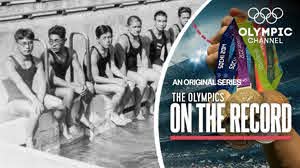In the early years of the 20th century, the United States owned Olympic swimming.
在20世纪初期,美国独霸奥运游泳比赛。
Every Summer Games, the best Americans proved way too strong for their international rivals.
每年夏季游泳比赛,是美国人向他们的国际对手证明自己强大最好的方式。
Stars like Duke Kahanamoku and Tarzan actor Johnny Weissmuller were famous around the world.
像杜克·卡哈莫纳库、“人猿泰山”约翰尼·维斯穆勒等体坛明星,他们都是世界闻名
How could a smaller nation, without the tradition and the resources of the USA, hope to compete against this sporting superpower?
一个小国,没有美国那样悠久的传统和资源,如何和一个运动强国去抗衡?
That was the question facing the Japanese in the early 1920s.
在20世纪20年代早期,日本也面临同样的问题。
Japan did not even enter a team for the swimming events at the Summer Games in Antwerp.
在安特卫普夏季奥运会中,日本队甚至都无法参与到游泳比赛中。
There were just two swimming pools in the whole of Japan.
当时整个日本只有两个游泳池。
And then...a little miracle.
然而奇迹发生了。
At the 1928 Olympic Games in Amsterdam, a Japanese railway worker called Yoshiyuki Tsuruta won the 200-metre breaststroke event.
在1928年的阿姆斯特丹奥运会上,日本的一个铁路工人叫鹤田义行,获得了200米蛙泳冠军。
It was only the second Olympic gold medal in Japanese history
这是日本历史上的第二枚奥运金牌,
and it had a quite extraordinary effect on the sport's popularity back home.
对这项运动在日本的流行产生了极大影响。
They remained way behind the United States, but it was a start.
虽然他们依旧落后于美国,但是这代表着一个开始。
And the Japanese were working on some new ideas.
日本国民开始尝试新的方法。
They had been watching the Americans and the way they achieved success.
他们持续观看和研究美国人取得成功的方法。
They watched and they learned.
仔细观看并学习。
They thought, "These guys are good, but we can do better."
他们想:“这些人是很厉害,但是我们可以做得更好。”
They started using underwater photography to see just what was going on beneath the surface.
他们开始利用水下摄影,去研究表面之下到底是怎么回事。
They were sports-science pioneers and what they discovered would change the way people swam.
他们是体育科学的先驱,他们的研究发现改变了当时人们游泳的方式。
Technically, the accepted convention was for the swimmer to be square-shouldered, to remain sturdy in the water with as little roll as possible.
从技术上说,公认的惯例是:游泳运动员肩膀要保持直角,尽可能减少摇晃,是为了在水中保持稳固。

But the Japanese were not convinced.
但是日本人不这样认为。
They tested other methods and found small but significant improvements.
他们尝试其他方法,做出了很小但是意义重大的改进。
Japanese swimmers were taught to roll their shoulders more, to increase the length of their arm movement, and to put more emphasis on their kicking
日本游泳运动员被训练肩膀要转动,来增加他们手臂移动的长度,同时把更多的重点放在反冲上面
freestyle, breaststroke, backstroke.
自由泳、蛙泳、仰泳。
They revised it, they tested it, they coached it.
他们不停的改进、测试、进行训练。
All of Japan started to get excited about the next Olympic Games in Los Angeles.
全日本都在为下一届的洛杉矶奥运会激动不已。
As the Japanese team set sail from Tokyo in 1932, there were 200,000 fans there to wave them off.
1932年,日本队在东京扬帆起航,20万粉丝聚集为他们挥手送行。
In LA, the first final was the 100m freestyle.
在洛杉矶奥运会中,100米自由泳是第一个结束的项目。
Gold for Yasuji Miyazaki. Silver for Tatsugo Kawaishi. USA in bronze.
鹤田义行拿到了金牌,河石达吾拿到了银牌,美国拿到了铜牌。
The relay would tell the world a great deal about the quality of Japanese swimming.
这种转折是在向全世界展示日本在游泳领域的实力。
The Japanese four were out of the pool before the USA had even finished the race.
四名日本运动员已经结束比赛走出泳池,此时美国的运动员还没有完成比赛。
The next day, the USA finally secured gold in the 400m freestyle.
第二天,美国队终于在400米的自由泳中拿到了金牌
One last desperate surge by Buster Crabbe of the US, and he just beats off Taris and sets a new Olympic record of 4 minutes, 48 and four-tenths seconds.
最后一个激动人心的时刻,由美国的克雷布带来,以4分48秒4的成绩,他打败了塔利斯,创造了新的奥运记录。
Then Japan dominated the 100m backstroke - gold, silver AND bronze.
之后日本队分别囊括了100米仰泳金牌、银牌和铜牌。
The eyes of the crowd are on the American flash, Adolph Kiefer,
公众的眼光都集中在了美国队的新星阿杜尔夫·基弗的身上,
18-year-old Chicago boy and the world's fastest dorsal swimmer,
18岁的芝加哥男孩,世界上最快的仰泳运动员,
who puts Japan's aquatic supremacy to a crucial test, who swept everything before them in 1932.
他向日本的水上霸权发起了挑战,1932年在他们之前克服了一切障碍。
The final day of the Olympic Gala saw another Japanese one-two in the 200m breaststroke followed by gold and silver again in the 1,500m freestyle.
最后一天的奥运盛会见证了日本两名运动员在200米蛙泳项目的荣誉,紧接着他们又在1500米的自由泳中斩获了金牌和银牌。
In four years, the Japanese had successfully turned the Olympic results table on its head.
四年时间里,日本成功地把奥运光环聚集到自己的头顶之上。
Eventually, the rest of the world caught up with the Japanese.
最终其他国家开始追赶日本。
They learned to race the proper way, the Japanese way.
他们学习正确的比赛方法,学习日本队的方法。
A comfortable win for Australia.
结果澳大利亚自然而然获胜。
Second place - Ford Konno, America. And third - Nikitin, Russia.
第二名是美国的福特·康诺,第三名是俄罗斯的尼基丁。
As that great swim coach Salvador Dali once said, "Only fools don't copy."
正如伟大的游泳教练萨尔瓦多•达利所说,“只有傻子才不会复制”











